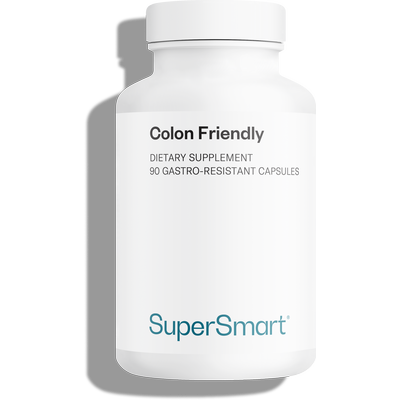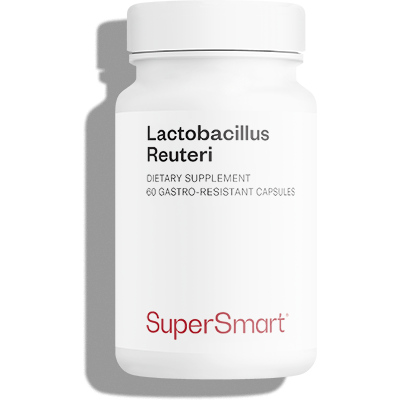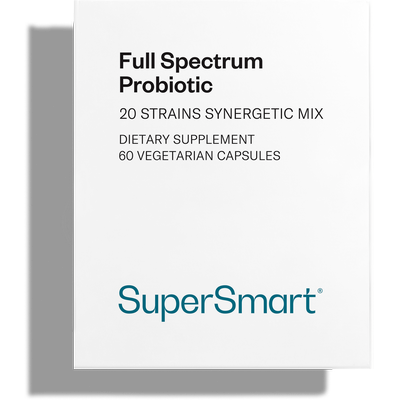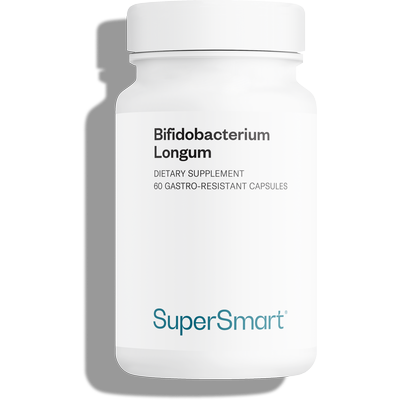Each type of prebiotic is thought to have a different impact on metabolic health
A recent study suggests that not all prebiotics have the same effect on metabolic health. Some are thought to help balance blood sugar levels, while others influence key metabolic markers such as homocysteine.

The impact of prebiotics on metabolic health: what does the study tell us?
Prebiotics are specific dietary fibres that our bodies do not digest, but which serve as food for probiotics, the 'good bacteria' that contribute to the balance of the intestinal microbiota.
By fermenting, they promote their growth and stimulate the production of beneficial metabolites.
However, a recent meta-analysis looked at the differences in effects between several types of prebiotics (1).
The researchers compared two types of prebiotics: inulin and fructo-oligosaccharides (FOS), and found that the two did not have the same effects on metabolic health.
The study reveals that:
- inulin had an impact on the regulation of blood sugar levels in overweight and obese people
- fructo-oligosaccharides (FOS) could play a role in regulating homocysteine (an amino acid associated with cardiovascular risk when present in excess) in people with normal blood sugar levels
These results open the way to more finely-tuned personalisation of prebiotic fibre intake.
They reinforce the idea that metabolic health depends not only on the quantity of fibre ingested, but also on its quality and diversity.
By feeding distinct groups of bacteria, each prebiotic is thought to encourage the production of different metabolites, with varying effects on the body.
Why aren't all fibres the same?
All prebiotic fibres share the ability to feed probiotics (2).
But their chemical structure and solubility determine how quickly they are fermented, and by what type of intestinal bacteria:
- inulin and FOS are thought to stimulate Bifidobacterium in particular (3), bacteria associated with good digestive regulation
- resistant starch favours Ruminococcus bromii and Faecalibacterium prausnitzii, (4-5) producers of butyrate, a short-chain fatty acid that protects the intestinal mucosa
- acacia gum is thought to act more slowly, but to favour strains such as Bifidobacterium and Lactobacillus over a longer period (6)
And the fermentation of fibres by these different bacteria produces several types of short-chain fatty acids (SCFAs): butyrate, propionate and acetate.
Each has different effects on blood sugar, cholesterol, inflammation and intestinal health:
- butyrate directly nourishes the intestinal cells (enterocytes), thereby supporting the integrity of the digestive barrier (7)
- propionate may help regulate blood sugar and cholesterol levels (8)
- acetate may be involved in regulating appetite (9)
Some prebiotics may also be involved in activating dietary polyphenols (10), thereby amplifying their benefits.
The initial composition of each person's microbiota may explain why the same fibres do not produce the same effects in everyone.
Where can I find prebiotic fibres?
While food remains the primary source of fibre, certain food supplements can provide a targeted intake of prebiotics.
Inulin: a versatile fibre
Inulin is a polysaccharide naturally present in chicory root, and also found in a number of vegetables such as garlic, onion, leek, artichoke and Jerusalem artichoke.
This fermentable prebiotic fibre feeds and stimulates the growth of certain probiotic strains, with the aim of promoting a balanced intestinal ecosystem.
This is why inulin is frequently used in food supplements, often in combination with probiotics for enhanced synergistic action.
![]() Discover Candalb and H. Pylori Fight Advanced Formula, high-quality synergistic supplements combining probiotics and inulin.
Discover Candalb and H. Pylori Fight Advanced Formula, high-quality synergistic supplements combining probiotics and inulin.
Fructo-oligosaccharides (FOS): targeted fibres for bifidobacteria
Fructo-oligosaccharides (FOS) are prebiotic fibres found naturally in foods such as bananas, asparagus, wheat, garlic and leeks.
What makes them special is their ability to selectively feed certain beneficial bacteria in the microbiota, in particular bifidobacteria (11).
![]() Discover Fructo-Oligosaccharides, a prebiotic fibre supplement derived from beetroot, easy to sprinkle into drinks or food.
Discover Fructo-Oligosaccharides, a prebiotic fibre supplement derived from beetroot, easy to sprinkle into drinks or food.
Acacia gum: a well-tolerated prebiotic
Acacia gum (or gum arabic) is a soluble fibre extracted from the sap of the acacia tree, traditionally used for its gentle and progressive effects on the microbiota (12).
Unlike other more fermentable fibres, it is renowned for its excellent digestive tolerance, making it an interesting option for prebiotic support that is accessible to everyone.
![]() Discover Organic Acacia, a 100% organic acacia gum, ideal for prolonged prebiotic support.
Discover Organic Acacia, a 100% organic acacia gum, ideal for prolonged prebiotic support.
Probiotics: the natural partners of prebiotics
Prebiotics act as fuel for probiotics, which help to balance the intestinal microbiota.
Particularly interesting strains include:
- Bifidobacterium longum, a probiotic often studied for its impact on digestion and immunity (13).
![]() Discover Bifidobacterium Longum, a highly concentrated probiotic supplement.
Discover Bifidobacterium Longum, a highly concentrated probiotic supplement.
- Lactobacillus rhamnosus GG, one of the most scientifically documented strains (14).
![]() Discover Lactobacillus Rhamnosus GG, a reference probiotic with 10 billion micro-organisms per day.
Discover Lactobacillus Rhamnosus GG, a reference probiotic with 10 billion micro-organisms per day.
- Lactobacillus reuteri, explored for its role in intestinal balance and oral health (15).
![]() Discover Lactobacillus Reuteri, an essential supplement in the form of gastro-resistant capsules.
Discover Lactobacillus Reuteri, an essential supplement in the form of gastro-resistant capsules.
- Lactobacillus gasseri, a strain widely studied for its potential effects on weight and abdominal fat (16).
![]() Discover Lactobacillus Gasseri, a recognised slimming ally that contributes to a balanced microbiota.
Discover Lactobacillus Gasseri, a recognised slimming ally that contributes to a balanced microbiota.
- Akkermansia muciniphila, a bacterium with promising effects on metabolic health (17).
![]() Discover Akkermansia Muciniphila, an innovative probiotic to help diversify the intestinal flora.
Discover Akkermansia Muciniphila, an innovative probiotic to help diversify the intestinal flora.
There are also multi-strain formulas, which combine several probiotics to maximise their effects.
![]() Discover Colon Friendly, a synergy of 4 renowned probiotic strains in powerful doses: Saccharomyces cerevisiae, Bifidobacterium longum infantis, Bifidobacterium longum longum and Lactobacillus acidophilus.
Discover Colon Friendly, a synergy of 4 renowned probiotic strains in powerful doses: Saccharomyces cerevisiae, Bifidobacterium longum infantis, Bifidobacterium longum longum and Lactobacillus acidophilus.
![]() Discover Full Spectrum Probiotic, a complete complex of high-quality probiotics, bringing together 20 synergistic strains.
Discover Full Spectrum Probiotic, a complete complex of high-quality probiotics, bringing together 20 synergistic strains.
By nourishing different bacteria in the microbiota, prebiotics could influence a variety of mechanisms: regulation of glycaemia and homocysteine, inflammation, integrity of the intestinal barrier, etc.
An interesting avenue would be to devise a personalised nutraceutical approach, combining a high-fibre diet with supplementation with high-quality prebiotics and probiotics.
SUPERSMART ADVICE
References
- Li J, Liu F, Luo Y, Wijeyesekera A, Wang S, Chen X, Lv Y, Jin J, Sheng H, Wang G, Wei Y, Li Z, Chen M, Zhou H. Differential effects of inulin and fructooligosaccharides on gut microbiota composition and glycemic metabolism in overweight/obese and healthy individuals: a randomized, double-blind clinical trial. BMC Med. 2025 Jul 1;23(1):372. doi: 10.1186/s12916-025-04189-6. PMID: 40598275; PMCID: PMC12219383.
- https://www.inserm.fr/c-est-quoi/reflorir-ou-faire-florir-c-est-quoi-probiotiques-et-prebiotiques/
- Nagy DU, Sándor-Bajusz KA, Bódy B, Decsi T, Van Harsselaar J, Theis S, Lohner S. Effect of chicory-derived inulin-type fructans on abundance of Bifidobacterium and on bowel function: a systematic review with meta-analyses. Crit Rev Food Sci Nutr. 2023 Nov;63(33):12018-12035. doi: 10.1080/10408398.2022.2098246. Epub 2022 Jul 14. PMID: 35833477.
- Ze X, Duncan SH, Louis P, Flint HJ. Ruminococcus bromii is a keystone species for the degradation of resistant starch in the human colon. ISME J. 2012 Aug;6(8):1535-43. doi: 10.1038/ismej.2012.4. Epub 2012 Feb 16. PMID: 22343308; PMCID: PMC3400402.
- Haenen D, Zhang J, Souza da Silva C, Bosch G, van der Meer IM, van Arkel J, van den Borne JJ, Pérez Gutiérrez O, Smidt H, Kemp B, Müller M, Hooiveld GJ. A diet high in resistant starch modulates microbiota composition, SCFA concentrations, and gene expression in pig intestine. J Nutr. 2013 Mar;143(3):274-83. doi: 10.3945/jn.112.169672. Epub 2013 Jan 16. PMID: 23325922.
- Alarifi S, Bell A, Walton G. In vitro fermentation of gum acacia - impact on the faecal microbiota. Int J Food Sci Nutr. 2018 Sep;69(6):696-704. doi: 10.1080/09637486.2017.1404970. Epub 2018 Jan 16. PMID: 29334803.
- Chen H, Qian Y, Jiang C, Tang L, Yu J, Zhang L, Dai Y, Jiang G. Butyrate ameliorated ferroptosis in ulcerative colitis through modulating Nrf2/GPX4 signal pathway and improving intestinal barrier. Biochim Biophys Acta Mol Basis Dis. 2024 Feb;1870(2):166984. doi: 10.1016/j.bbadis.2023.166984. Epub 2023 Dec 6. PMID: 38061600.
- Haghikia A, Zimmermann F, Schumann P, Jasina A, Roessler J, Schmidt D, Heinze P, Kaisler J, Nageswaran V, Aigner A, Ceglarek U, Cineus R, Hegazy AN, van der Vorst EPC, Döring Y, Strauch CM, Nemet I, Tremaroli V, Dwibedi C, Kränkel N, Leistner DM, Heimesaat MM, Bereswill S, Rauch G, Seeland U, Soehnlein O, Müller DN, Gold R, Bäckhed F, Hazen SL, Haghikia A, Landmesser U. Propionate attenuates atherosclerosis by immune-dependent regulation of intestinal cholesterol metabolism. Eur Heart J. 2022 Feb 10;43(6):518-533. doi: 10.1093/eurheartj/ehab644. PMID: 34597388; PMCID: PMC9097250.
- Frost G, Sleeth ML, Sahuri-Arisoylu M, Lizarbe B, Cerdan S, Brody L, Anastasovska J, Ghourab S, Hankir M, Zhang S, Carling D, Swann JR, Gibson G, Viardot A, Morrison D, Louise Thomas E, Bell JD. The short-chain fatty acid acetate reduces appetite via a central homeostatic mechanism. Nat Commun. 2014 Apr 29;5:3611. doi: 10.1038/ncomms4611. PMID: 24781306; PMCID: PMC4015327.
- Plamada D, Vodnar DC. Polyphenols-Gut Microbiota Interrelationship: A Transition to a New Generation of Prebiotics. Nutrients. 2021 Dec 28;14(1):137. doi: 10.3390/nu14010137. PMID: 35011012; PMCID: PMC8747136.
- Mitsuoka T, Hidaka H, Eida T. Effect of fructo-oligosaccharides on intestinal microflora. Nahrung. 1987;31(5-6):427-36. doi: 10.1002/food.19870310528. PMID: 3657917.
- Rawi MH, Abdullah A, Ismail A, Sarbini SR. Manipulation of Gut Microbiota Using Acacia Gum Polysaccharide. ACS Omega. 2021 Jul 2;6(28):17782-17797. doi: 10.1021/acsomega.1c00302. PMID: 34308014; PMCID: PMC8296006.
- Shang F, Jiang X, Wang H, Guo S, Kang S, Xu B, Wang X, Chen S, Li N, Liu B, Zhao Z. Bifidobacterium longum suppresses colorectal cancer through the modulation of intestinal microbes and immune function. Front Microbiol. 2024 Mar 22;15:1327464. doi: 10.3389/fmicb.2024.1327464. PMID: 38585690; PMCID: PMC10995357.
- Capurso L. Thirty Years of Lactobacillus rhamnosus GG: A Review. J Clin Gastroenterol. 2019 Mar;53 Suppl 1:S1-S41. doi: 10.1097/MCG.0000000000001170. PMID: 30741841.
- Teughels W, Durukan A, Ozcelik O, Pauwels M, Quirynen M, Haytac MC. Clinical and microbiological effects of Lactobacillus reuteri probiotics in the treatment of chronic periodontitis: a randomized placebo-controlled study. J Clin Periodontol. 2013 Nov;40(11):1025-35. doi: 10.1111/jcpe.12155. Epub 2013 Sep 15. PMID: 24164569; PMCID: PMC3908359.
- Kim J, Yun JM, Kim MK, Kwon O, Cho B. Lactobacillus gasseri BNR17 Supplementation Reduces the Visceral Fat Accumulation and Waist Circumference in Obese Adults: A Randomized, Double-Blind, Placebo-Controlled Trial. J Med Food. 2018 May;21(5):454-461. doi: 10.1089/jmf.2017.3937. Epub 2018 Apr 24. PMID: 29688793.
- Rodrigues VF, Elias-Oliveira J, Pereira ÍS, Pereira JA, Barbosa SC, Machado MSG, Carlos D. Akkermansia muciniphila and Gut Immune System: A Good Friendship That Attenuates Inflammatory Bowel Disease, Obesity, and Diabetes. Front Immunol. 2022 Jul 7;13:934695. doi: 10.3389/fimmu.2022.934695. PMID: 35874661; PMCID: PMC9300896.
Keywords
3 Days
I like your clear explanation
I like your clear explanation. And how to make a choice of products for a specific health problem
Ingrid
9 Days
Great product and it arrives quickly.
Great product and it arrives quickly.
SOMMARIVA Gianni
11 Days
Excellent products and fast service.
Excellent products and fast service. What do we need more?
Margarida
15 Days
The variety of products is amazing
The variety of products is amazing, the offers are good and the sending is very fast. I just miss having a bit more of guidance about combinations, possible interactions, etc.
Maria Angeles Verdu
16 Days
It was quick
It was quick.
Timo Antero
18 Days
Who is a good boy? You, you are! Yes, yes
:) :(:) :(:) :(:) :(
JORGE Catalan Gasco
21 Days
Excellent online site
Excellent online site, efficient and quick delivery. A great experience.
Chris
24 Days
I’m really happy with your products, but…
I’m really happy with your products. Indeed, I’ve been a customer of SuperSmart for a long time. However, I believe that lately you’ve made a significant mistake in choosing Poste Italiane for your deliveries. Poste Italiane is now over loaded and assigns the deliveries to small local companies that have grown like mushrooms because of this business. However, the service they provide is very poor. They let you know about the delivery date just the evening before, with no time to organize yourself, many times you receive a message saying that they tried to deliver but you were not home and in reality they haven’t come at all and, when they do come, you open the door of the building ( I live on the 3rd floor) and when you get downstairs they have already left, leaving the pack inside but right behind the glass door instead of at least putting it on top or under the letterbox. This is not just a one time event but it’s their way of proceeding. It would be worth hiring a professional currier. Thanks
Olga Gladys Del Signore
24 Days
Good products
Good products, fast service
Mrs I Heinrich
31 Days
Quality products and fast shipping.
Quality products and fast shipping.
JF
32 Days
Everything is great. Keep up
Your product and service is great that's why i ordered again.
KOSMATOS Stamatios
36 Days
everything as expected
the products work and the processes to support them also
Ruggero Benedetto
38 Days
Excellent products always up to date…
Excellent products always up to date with the latest developments.
Olga Gladys Del Signore
42 Days
Great service
Great service, exceptional delivery time.
Chris
44 Days
Excellent quality of Super Smart
I’ve used Super Smart products for a long time and since the very beginning I have been absolutely keen about their punctuality in delivering but, most of all, I appreciate the quality of their products and the constant updates following the results of proven research.
Olga Gladys Del Signore









